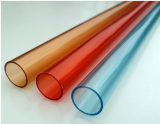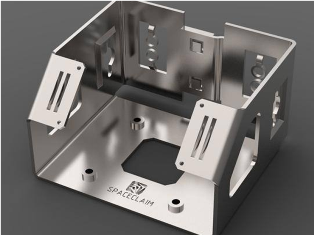
Plastic Injection Molding Manufacturing Company - custom injection molding
Author:gly Date: 2024-10-15
Injection molding is a manufacturing process that consists of filling a metal mold cavity with liquid plastic resin, which then cools and forms a plastic part.
Being a semicrystalline material, the molding shrinkage is high (order of 0.015 - 0.04 mm/mm or 1.5 - 4%). This is dependent on the degree of orientation and level of crystallinity in the part (which in turn are dependent on processing conditions and part design).
Resin pellets are loaded into a barrel where they will eventually be melted, compressed, and injected into the mold’s runner system. Hot resin is shot into the mold cavity through the gates and the part is molded. Ejector pins facilitate removal of the part from the mold where it falls into a loading bin. When the run is complete, parts (or the initial sample run) are boxed and shipped shortly thereafter.
Our basic guidelines for plastic injection molding include important design considerations to help improve part moldability, enhance cosmetic appearance, and reduce overall production time. View our design guidelines page for more details.
Our thermoplastic injection molding is a standard process involving an aluminum mold with no heating or cooling lines running through it, which means cycle times are a bit longer. As part of the scientific molding process, our molders independently optimize and monitor fill speed, hold pressure, and hold time, and periodically inspect part quality and cosmetics. During the molding process, we use an automated inline CMM to ensure dimensional accuracy, as well as generate a detailed process capability study and FAI report.
It's most often used for the manufacturing plastic parts at scale due to its low material waste and low cost per part. It’s an ideal manufacturing process for industries like medical devices, consumer products, and automotive.

When the density is 0.91 - 0.925 g/cm^3, the material is known as Type 1; Type 2 materials have densities in the range of 0.926 - 0.94 g/cm^3, and Type 3 materials have densities in the range of 0.94 - 0.965 g/cm^3.
20 - 95 C (68 - 194 F) (higher temperatures for wall thickness of up to 6 mm; lower temperature for wall thicknesses greater than 6 mm.) The cooling rate should be uniform to minimize shrinkage variations. For optimum cycle times, the cooling channel diameters should be at least 8 mm and must be within a distance of 1.3 d from the mold surface (where "d" is the diameter of the cooling channel).
Our digital factories create prototypes and low-volume parts fast, while our manufacturing network, offers advanced capabilities and volume pricing.
Get machined parts anodized and chromate plated with our quick-turn finishing option. Eligible materials include aluminum 6061/6082 and 7075.
It has been very enlightening to us here at HP that we are able to get parts so rapidly out of the actual materials that we're going to use in the final production.
Critical-to-quality (CTQ) dimensions you call out on models let us know what areas are most crucial to the success of your parts. Once the parts start molding, the process and samples are qualified using automated inline CMM technology, generating a detailed FAI and process capability study with no additional lead time.
Tolerances: Typically, Protolabs can maintain a machining tolerance of +/- 0.003 in. (0.08mm) with an included resin tolerance that can be greater than but no less than +/- 0.002 in./in. (0.002mm/mm).
PE is susceptible to environmental stress cracking, which can be minimized by reducing internal stresses by proper design and using the lowest MFR material at a particular density level. HDPE is soluble in hydrocarbons at temperatures greater than 60 C, but resistance to these materials is greater than that for LDPE.
No one ever said that designing and manufacturing molded parts was easy. Our goal is to get you through it quickly and with quality parts. A good starting point is our Design for Moldability Toolkit.
HDPE injection molding processing condition Generic Class HDPE (High Density Polyethylene) Typical Applications Containers in refrigeration units, storage vessels, household goods (kitchenware), seal caps, bases for PET bottles, etc. Major use is in blow-molding applications (packaging applications) Injection Molding Processing conditions Drying Not normally necessary if stored properly. Melt Temperature 180 - 280 C (356 - 536 F); for high molecular weigh grades, the suggested melt temperature range is 200 - 250 C (392 - 482 F) Mold Temperature 20 - 95 C (68 - 194 F) (higher temperatures for wall thickness of up to 6 mm; lower temperature for wall thicknesses greater than 6 mm.) The cooling rate should be uniform to minimize shrinkage variations. For optimum cycle times, the cooling channel diameters should be at least 8 mm and must be within a distance of 1.3 d from the mold surface (where "d" is the diameter of the cooling channel). Material Injection Pressure 70 - 105 MPa Injection Speed High injection velocity is recommended; profile injection velocity can be used to reduce warpage in the case of components with a large surface area. Runners and Gates Diameters of runners range from 4 - 7.5 mm (typically 6 mm). Runner lengths should be as short as possible. All types of gates may be used. Gate lands should not exceed 0.75 mm in length. Ideally suited for hot runner molds; an insulated hot tip runner is preferred when there are frequent color changes. If you need high quality cutom aluminium casting parts Pls contact us sales@viewmold.com If you need high quality injection mold tooling, Contact us. Chemical and Physical Properties High density polyethylene is produced from polymerization of ethylene (lower temperature and pressure conditions are used compared to the production of low density polyethylene). The material is free from branching and this is made possible by the use of stereospecific catalysts. Because of molecular regularity, HDPE has a high level of crystallinity (compared to LDPE). Higher levels of crystallinity contribute to higher density, tensile strength, heat distortion temperature, viscosity, and chemical resistance. HDPE is more resistant to permeability than LDPE. The impact strength is lower. The properties of HDPE are controlled by the density, and molecular weight distributions. Injection molding grades typically have a narrow molecular weight distribution. When the density is 0.91 - 0.925 g/cm^3, the material is known as Type 1; Type 2 materials have densities in the range of 0.926 - 0.94 g/cm^3, and Type 3 materials have densities in the range of 0.94 - 0.965 g/cm^3. The material flows easily and the MFR ranges from 0.1 - 28. Higher molecular weights (lower MFR grades) have better impact resistance. Being a semicrystalline material, the molding shrinkage is high (order of 0.015 - 0.04 mm/mm or 1.5 - 4%). This is dependent on the degree of orientation and level of crystallinity in the part (which in turn are dependent on processing conditions and part design). PE is susceptible to environmental stress cracking, which can be minimized by reducing internal stresses by proper design and using the lowest MFR material at a particular density level. HDPE is soluble in hydrocarbons at temperatures greater than 60 C, but resistance to these materials is greater than that for LDPE. If you need to look for more plastic resin injection molding processing condition, could you please click it. If you need high quality plastic extrusion services, Pls contact us sales@viewmold.com If you need high quality sheet metal parts, Pls contact us sales@viewmold.com The following is other plastic processing condition: ABS injection molding processing condition, HDPE injection molding processing condition, LDPE injection molding processing condition, PA12 injection molding processing condition, PA6 injection molding processing condition, PBT injection molding processing condition, PC-ABS injection molding processing condition, PC-PBT injection molding processing condition, PEI injection molding processing condition, PETG injection molding processing condition, PMMA injection molding processing condition, POM injection molding processing condition, PPE injection molding processing condition, HDPE injection molding processing condition, PP injection molding processing condition, PS injection molding processing condition, PVC injection molding processing condition, SAN injection molding processing condition,
This complete reference guide walks you through everything from quoting, design analysis, and shipment to best practices that ensure your model is optimized for molding.
Tough Black (Loctite Henkel 3843) and Ceramic-Filled (BASF 3280) are two new advanced photopolymer materials now available for 3D printing.
Our helpful design aid demonstrates part features that are too thin or too thick, bad bosses, right and wrong ribs, and other considerations to be mindful of while designing parts for injection molding.

We have wide selection of more than 100 thermoplastic and thermoset materials. And if you're looking for alternative material options, check out our guide to resin substitutes for ABS, PC, PP, and other commonly molded plastics.
The manufacturing process for molded parts is complex. Before your parts are even molded, we're there to help you with comprehensive manufacturability feedback and consultative design services, so you can avoid mold design pitfalls before the resin hits the mold. From there, our production process is documented and optimized using scientific molding so you get high-quality parts consistently and reliably with every production run.
While the molds themselves are similar, part quantities, lifetime maintenance, quality documentation, and pricing vary depending on which service option is chosen. The right one depends on your project needs.
Diameters of runners range from 4 - 7.5 mm (typically 6 mm). Runner lengths should be as short as possible. All types of gates may be used. Gate lands should not exceed 0.75 mm in length. Ideally suited for hot runner molds; an insulated hot tip runner is preferred when there are frequent color changes.

Higher levels of crystallinity contribute to higher density, tensile strength, heat distortion temperature, viscosity, and chemical resistance. HDPE is more resistant to permeability than LDPE. The impact strength is lower. The properties of HDPE are controlled by the density, and molecular weight distributions. Injection molding grades typically have a narrow molecular weight distribution.
Our plastic injection molding process produces custom prototypes and end-use production parts with lead times as fast as 1 day. We use aluminum molds that offer cost-efficient tooling and accelerated manufacturing cycles, and stock about 200 different thermoplastic resins.
The material flows easily and the MFR ranges from 0.1 - 28. Higher molecular weights (lower MFR grades) have better impact resistance.
Containers in refrigeration units, storage vessels, household goods (kitchenware), seal caps, bases for PET bottles, etc. Major use is in blow-molding applications (packaging applications)
High injection velocity is recommended; profile injection velocity can be used to reduce warpage in the case of components with a large surface area.
Want to learn more about injection molding? Sign up to receive a Design Cube. This physical aid demonstrates how to properly design features commonly found on molded parts.
Depending on your application's requirements, you can choose from the following when requesting an injection molding quote.
Proto Labs, Inc. 5540 Pioneer Creek Dr. Maple Plain, MN 55359 United States P: 877-479-3680 F: 763-479-2679 E: [email protected]
180 - 280 C (356 - 536 F); for high molecular weigh grades, the suggested melt temperature range is 200 - 250 C (392 - 482 F)
High density polyethylene is produced from polymerization of ethylene (lower temperature and pressure conditions are used compared to the production of low density polyethylene). The material is free from branching and this is made possible by the use of stereospecific catalysts. Because of molecular regularity, HDPE has a high level of crystallinity (compared to LDPE).
GETTING A QUOTE WITH LK-MOULD IS FREE AND SIMPLE.
FIND MORE OF OUR SERVICES:


Plastic Molding

Rapid Prototyping

Pressure Die Casting

Parts Assembly



